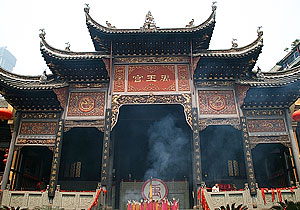Huguang Guild Hall

Located at East Shuimen Street of Chongqing City, the Huguang Guild Hall, actually a general name for several guild halls in Chongqing, has grown up at the end of Ming Dynasty (1368-1644) and the beginning of Qing Dynasty (1644-1911) when a large number of immigrants from Huguang area (today's provinces of Hunan, Hubei, Jiangxi, Guangdong, and Guangxi) migrate to Chongqing to develop local economy development.
The original Huguang Guild Hall, also known as Yuwang Palace, was built at the beginning of Qing Dynasty. In later Qing Dynasty, some other guild halls such as the Guangdong Hall (built at about 1662—1722), Qi'an Hall (built at 1817) were built beside Yuwang Palace.
It is a pity that some buildings were damaged by natural disasters or destroyed in the Cultural Revolution in the 1970s. The existing Huguang Guild Hall is renovated in recent two decades, now covering 7634 kilometers. Besides the above mentioned halls, the renovated Hall includes some other newly-built reproducing structures and an Immigrant Museum, which is China's first specialized museum about immigrants.
The building complex represents the classic architecture and art style in southern China of Ming and Qing Dynasty, shown from the traditional ways and styles of making roofs, attics, multi-storied pavilion, etc. The highlights of this building complex is that delicate carvings with human figures, animals and plants in classic stories can be seen everywhere.
The local opera is said to be excellent, especially watching from Guangdong Hall and Qi'an Hall. But the halls are sometimes bustling at the peak time of tourism.